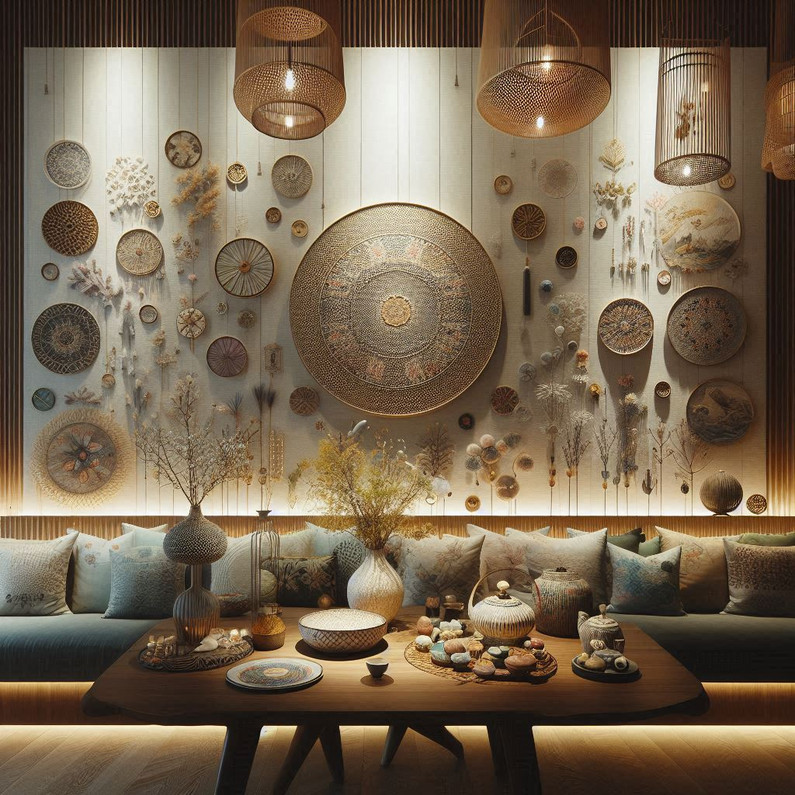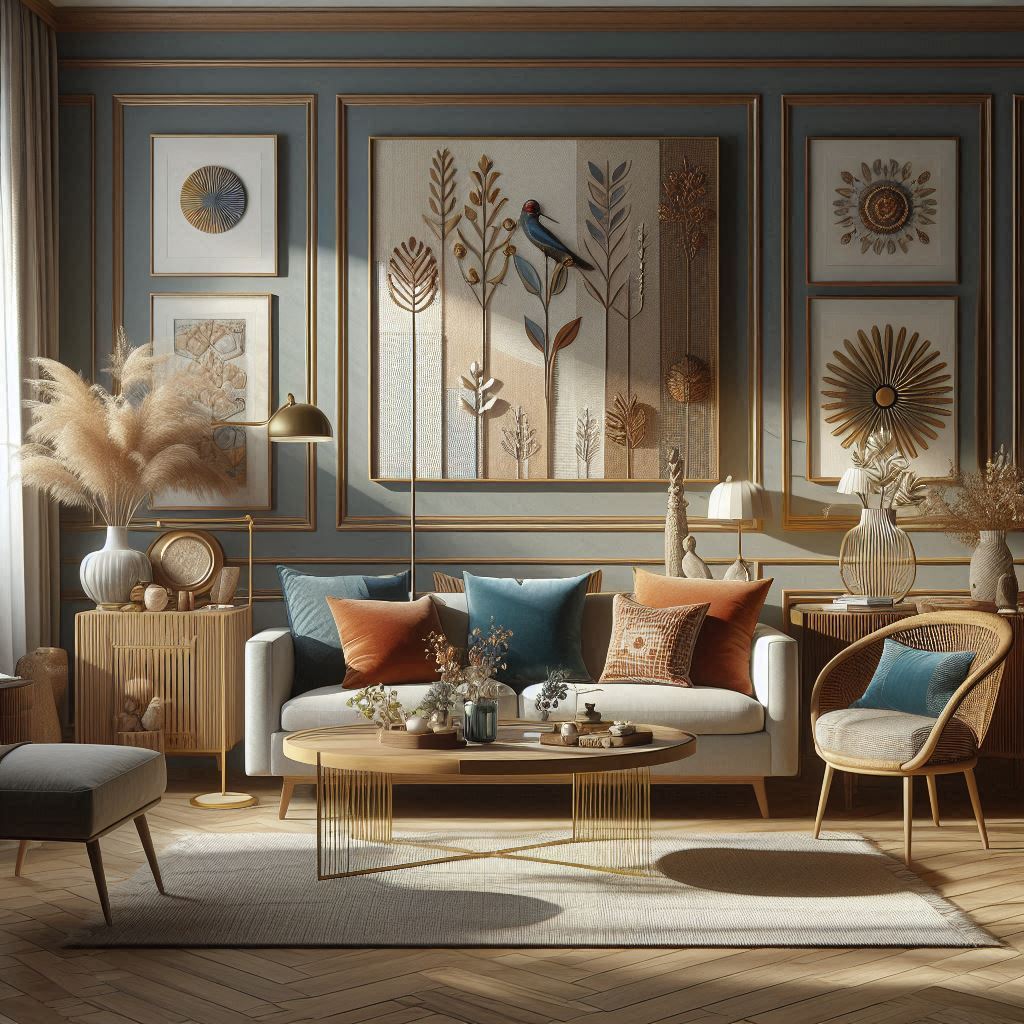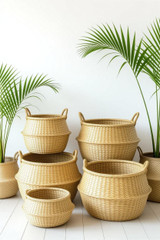The Art of Textiles in Interior Design: Elevating Spaces with Texture and Color
Textiles play a pivotal role in shaping the atmosphere and functionality of any interior space. From plush rugs to soft drapes and intricately woven throws, textiles add personality, warmth, and style to a room. Whether you’re looking to enhance a cozy nook or make a bold statement, understanding how to incorporate textiles into your interiors can transform your home into a well-balanced, aesthetically pleasing environment.
1. The Power of Textures
Textiles bring depth and character to any space, with texture being one of their most defining features. Smooth, luxurious silk contrasts with rough, natural linens to create visual interest and tactile appeal. Mixing different textures within a space can elevate its sensory richness. For example, pairing a velvet sofa with a chunky wool throw creates a sense of balance, combining the smoothness of velvet with the inviting warmth of wool. This juxtaposition helps spaces avoid feeling flat or one-dimensional.
Pro tip: Layer various materials like cotton, wool, and leather to bring in both comfort and style. Choose fabrics that align with the overall design theme of your room, such as sleek silks for a modern look or handwoven textiles for a rustic or bohemian vibe.
2. Color and Patterns: Setting the Tone
Textiles are also one of the easiest and most effective ways to introduce color into a space. Bold, vibrant hues can energize a room, while soft, muted tones create a tranquil and relaxing atmosphere. Patterned textiles can add personality and make a room visually interesting. From intricate florals to geometric shapes, patterns can express your personal style and tie in the design elements of the room.
Choosing complementary or contrasting colors can dramatically impact the feel of a space. For example, using warm earth tones like terracotta or ochre in textiles can create a cozy, grounded environment, while cool blues and greens foster a calm, serene atmosphere.
Pro tip: Balance patterned textiles with solid-colored pieces to avoid overwhelming the space. If you want to create a focal point, consider using bold patterned fabrics for window treatments, pillows, or accent rugs.
3. Functionality Meets Aesthetics
Beyond their aesthetic appeal, textiles also serve practical purposes in interior design. Curtains and drapes provide privacy while controlling light and temperature, making rooms feel more comfortable. Upholstered furniture offers both comfort and style, and throw blankets can serve as decorative elements that are also functional for chilly nights.
Rugs, one of the most versatile textiles, can delineate spaces, reduce noise, and add warmth to cold floors. Large area rugs in open floor plans, for example, help define distinct living zones. In bedrooms, soft rugs or carpeting not only enhance comfort but also offer insulation.
Pro tip: Choose textiles that are durable and suited to the room's function. High-traffic areas like living rooms and hallways benefit from stain-resistant and hard-wearing fabrics, while bedrooms can be enhanced with softer, more delicate materials.
4. Global Inspiration and Artisanal Textiles
Textiles are a beautiful way to introduce global influences into your home. Handcrafted pieces from different cultures, like Turkish kilims, Moroccan rugs, Indian block-printed fabrics, or Mexican serapes, add rich cultural history and artistry to a room. These textiles, often created using traditional methods, bring uniqueness and a story that mass-produced fabrics may lack.
By incorporating artisanal textiles, you're not only enhancing your space but also supporting traditional crafts and sustainability efforts.
Pro tip: Use global textiles as focal points. A handwoven tapestry or an embroidered pillow can act as an art piece, while smaller items like throw blankets or table linens can subtly introduce cultural diversity into your interior design.
5. Layering Textiles for Depth and Comfort
One of the key techniques in creating inviting interiors is layering textiles. By layering fabrics of varying textures, colors, and patterns, you can create a cozy, lived-in feel while adding depth to the space. For example, start with a base layer of neutral tones in upholstery, then build upon that with patterned throw pillows, a textured blanket, and a statement rug.
Layering also allows you to adjust the look and feel of a room based on the season. Swap out lightweight cottons and linens in the summer for heavier wools and velvets during colder months.
Pro tip: Consider layering textiles of different sizes and scales. For example, a large, neutral area rug can be overlaid with a smaller, colorful accent rug to add visual interest and define a space within a space.
6. Personalization and Customization
Textiles offer endless opportunities for personalization in interior design. From custom-upholstered furniture to one-of-a-kind curtains and pillows, textiles allow you to bring your vision to life in ways that other elements may not. They are a medium through which you can express your individuality and set your space apart.
Custom textile designs also allow you to choose colors, patterns, and textures that align perfectly with your overall decor scheme. Whether it’s a bold custom bedspread, hand-embroidered wall hangings, or printed cushions that reflect your unique style, textiles enable you to curate a space that feels truly yours.
Pro tip: Don't hesitate to mix custom-made pieces with ready-made textiles. This combination ensures a harmonious blend of personal style and practicality.
Conclusion
Textiles in interior design are more than just decorative accessories; they are essential elements that bring texture, color, warmth, and personality to a space. Whether you opt for bold prints or subtle textures, textiles offer endless possibilities to enhance your home's interior. By carefully selecting and layering textiles, you can create a balanced, inviting, and personalized space that reflects your style and enhances your living environment.
Incorporating textiles thoughtfully allows you to transform your interiors into spaces that are both functional and beautiful, adding the perfect finishing touch to any room.
Recent Posts
-
Order the Best Boss Day Gifts for Male & Female Bosses in the UAE from Craftihouse.com
Every year, Boss’s Day is the perfect opportunity to show appreciation for the people who lead, ment …13th Oct 2025 -
How This Gift Came to Life: The Story Behind Our Palm Leaf Baskets
How This Gift Came to Life: The Story Behind Our Palm Leaf Baskets In a world where everything is be …8th Oct 2025 -
Handmade Leather Key Chains – Timeless Souvenirs & Everyday Companions
Handmade Leather Key Chains – Timeless Souvenirs & Everyday Companions Introduction In a world where …25th Sep 2025





